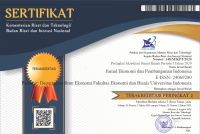Abstract
This study aims to explain the effect of socio-demographic variables i.e. sex, wage, employment status, and marital status on commuting in Jabodetabek. The result of binary logistic regression using Sakernas 2012 shows that male are more likely to commute than female. Male in formal sector have the highest probability to commute while by marital status, unmarried male have the highest probability to commute. The level of wage is positively related with the probability to commute although at certain level of wage, an increase in wage increases probability to commute among male lower than probability to commute among female.
Bahasa Abstract
Studi ini bertujuan untuk melihat pengaruh variabel sosio-demografis yaitu jenis kelamin, upah, status kerja, dan status kawin terhadap peluang mobilitas ulang-alik di Jabodetabek. Hasil regresi logit biner menggunakan data Sakernas 2012 menunjukkan bahwa laki-laki lebih cenderung untuk ulang-alik diban- dingkan dengan perempuan. Peluang ulang-alik paling tinggi menurut status kerja adalah pada pekerja laki-laki di sektor formal dan menurut status kawin adalah pada pekerja laki-laki belum kawin. Ditemukan hubungan positif antara kenaikan tingkat upah dengan ulang-alik walaupun pada tingkat tertentu, kenaikan peluang ulang-alik untuk laki-laki akibat kenaikan tingkat upah lebih kecil dibandingkan kenaikan peluang ulang-alik untuk perempuan.
References
[1] Artis, M., Romani, J., & Surinach, J. (2000). Determinants of Individual Commuting in Catalonia, 1986{91: Theory and Empirical Evidence. Urban Studies, 37 (8), 1431-1450.
[2] BPS. (2012). Indikator Pasar Tenaga Kerja Indonesia (Indonesia Labor Market Indicators), Februari 2012. Jakarta: Badan Pusat Statistik.
[3] Carlson, V. L. & Persky, J. J. (1999). Gender and Suburban Wages. Economic Geography, 75 (3), 237-253.
[4] Dubin, R. (1991). Commuting Patterns and Firm Decentralization. Land Economics, 67 (1), 15-29.
[5] England, K. V. L. (1993). Suburban Pink Collar Ghettos: The Spatial Entrapment of Women? Annals of the Association of American Geographers, 83 (2), 225-242.
[6] Farber, S. & Paez, A. (2010). Employment Status and Commute Distance of Canadians with Disabilities. McMaster University, Canada: Springer.
[7] Firman, T. (1996). Pola Urbanisasi di Indonesia. Dalam Aris A. & Chotib (Eds.), Mobilitas Penduduk di Indonesia. Jakarta: Lembaga Demografi Fakultas Ekonomi Universitas Indonesia dan Kantor Menteri Negara Kependudukan/BKKBN.
[8] Goldner, W. (1955). Spatial and Locational Aspects of Metropolitan Labor Markets. The American Economic Review, 45 (1), 113-128.
[9] Hugo, G. (1981). Population Mobility in West Java. Yogyakarta: Gadjah Mada University Press.
[10] Jones, G. W. (1988). Urbanization Trends in Southeast Asia: Some Issues for Policy. Journal of Southeast Asian Studies, 19 (1), 137-154.
[11] Madden, J. F. & White, M. J. (1980). Spatial Implications of Increases in the Female Labor Force: A Theoretical and Empirical Synthesis. Land Economics, 56, (4), 432-446.
[12] McLafferty, S. & Preston, V. (1992). Spatial Mismatch and Labor Market Segmentation for African-American and Latina Woman. Economic Geography, 68 (4), 406-431.
[13] Rachmad, S. H., Adji, A., & Handiyatno, D. (2012). Gendered Patterns of Urban Commuting with Better Connectivity in Jakarta Megapolitan Area. In Kyoko Kusakabe (Ed.), Gender, Roads, and Mobility in Asia. U. K.: Pratical Action Publishing Ltd.
[14] Rapino, M. A. (2008). Gender Roles and Spatial Entrapment. Doctoral Dissertation. United States: University of Connecticut.
[15] Renkow, M. (2003). Employment Growth, Worker Mobility, and Rural Economic Development. American Journal of Agricultural Economics, 85 (2), 503-513.
[16] Ruppert, P., Stancanelli, E., & Wasmer, E. (2009). Commuting, Wages and Bargaing Power. Annals of Economics and Statistics, 95/96, 201-220.
[17] Saefullah, H. A. D. (1996). Mobilitas Internal Nonpermanen. Dalam Aris A. & Chotib (Eds.), Mobilitas Penduduk di Indonesia. Jakarta: Lembaga Demografi Fakultas Ekonomi Universitas Indonesia dan Kantor Menteri Negara Kependudukan/ BKKBN.
[18] Semyonov, M. & Lewin-Epstein, N. (1991). Suburban Labor Markets, Urban Labor Markets, and Gender Inequality in Earnings. The Sociological Quarterly, 32 (4), 611-620.
[19] Sumner, D. A. (1981). Wage Functions and Occupational Selection in a Rural Less Developed Country Setting. The Review of Economics and Statistics, 63 (4), 513-519.
[20] Thomson, J. H. (1956). Commuting Patterns of Manufacturing Employees. Industrial and Labor Relation Review, 10 (1), 70-80.
[21] Todaro, M. P. (1982). Economics for a Developing World, 2nd Edition. Essex, U. K.: Longman.
[22] van den Berg, G. J. & Gorter, C. (1997). Job Search and Commuting Time. Journal of Business & Economic Statistics, 15 (2), 269-281.
[23] Van Ommeren, J. & Rietveld, P. (2007). Commuting and Reimbursement of Residential Relocation Costs. Journal of Transport Economics and Policy, 41 (1), 51-73.
[24] Wheeler, J. O. (1967). Occupational Status and Work-Trips: A Minimum Distance Approach. Social Forces, 45 (4), 508-515.
[25] White, M. J. (1986). Sex Differences in Urban Commuting Patterns. The American Economic Review, 76 (2), 368-372.
[26] World Bank. (2012). The Rise of Metropolitan Regions: Towards Inclusive and Sustainable Regional Development. http: //www.worldbank.org/in/news/2012/08/13/ towards-inclusive-andsustainable-regional- development (Accessed August 13, 2012).
Recommended Citation
Warsida, Rotua Y.; Adioetomo, Sri M.; and Pardede, Elda L.
(2013)
"Pengaruh Variabel Sosio-Demografis terhadap Mobilitas Ulang-Alik di Jabodetabek,"
Jurnal Ekonomi dan Pembangunan Indonesia: Vol. 13:
No.
2, Article 4.
DOI: 10.21002/jepi.v13i2.04
Available at:
https://scholarhub.ui.ac.id/jepi/vol13/iss2/4







